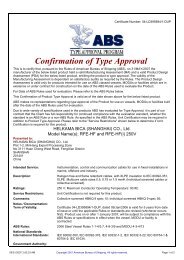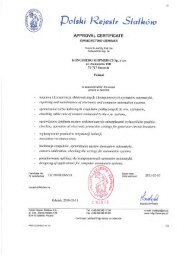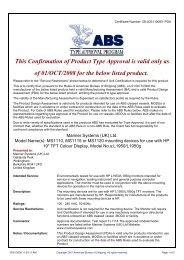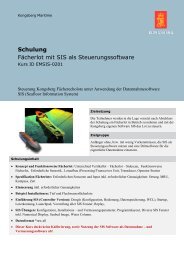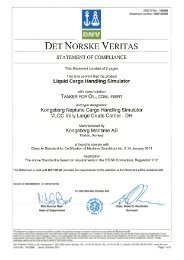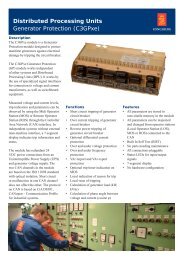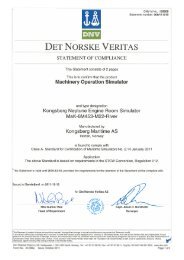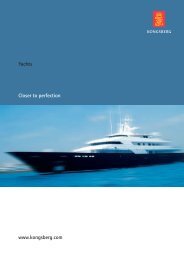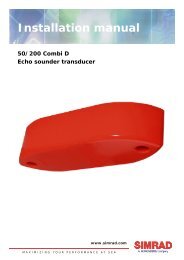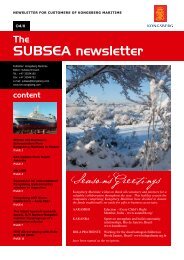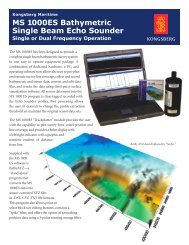Annual Report 2011 - Kongsberg Maritime - Kongsberg Gruppen
Annual Report 2011 - Kongsberg Maritime - Kongsberg Gruppen
Annual Report 2011 - Kongsberg Maritime - Kongsberg Gruppen
You also want an ePaper? Increase the reach of your titles
YUMPU automatically turns print PDFs into web optimized ePapers that Google loves.
control. Goodwill is calculated at the time control is obtained. On each<br />
individual acquisition, it is decided whether goodwill should be limited to<br />
KONGSBERG’s proportionate share or to include non-controlling<br />
interests. Entities that constitute the Group are listed in Note 30 “List of<br />
Group companies”.<br />
Contingent considerations to be disbursed at a later date when<br />
certain conditions of the acquisition are met, are recognised at fair value<br />
on the date of the acquisition. Subsequent changes in the fair value of<br />
contingent consideration classified as an asset or liability are recognised<br />
according to IAS 39 on either the income statement or the statement of<br />
comprehensive income.<br />
Transaction costs incurred in connection with the business combination<br />
are recognised as expenses on an ongoing basis.<br />
Elimination of transactions<br />
All intra-group balances and unrealised gains and losses that arise between<br />
Group entities are eliminated in full. Unrealised losses are<br />
eliminat ed correspondingly, unless they are related to impairment which<br />
requires that they are included in the consolidated financial statements.<br />
Non-controlling interests<br />
Non-controlling interests are included in the Group’s equity as a<br />
separate line item. Its portion of the result is included in the profit for<br />
the year. Non-controlling interests include the portion of the fair value of<br />
the subsidiary, including its share of identified excess value on the date<br />
of acquisition. The portion of the comprehensive income is attributed to<br />
the non-controlling interest even if that results in a deficit balance.<br />
B) Foreign currency<br />
The Group`s consolidated financial statements are presented in NOK<br />
(Norwegian kroner), which is also the parent company’s functional<br />
currency. Each entity in the Group determines its own functional<br />
currency and items included in the financial statements of each entity<br />
are measured using that functional currency. Upon initial recognition,<br />
foreign currency transactions are measured in the functional currency<br />
on the date of the transaction. Construction contracts are hedged and<br />
recognised based on the hedged exchange rate (project hedges). Trade<br />
receivables, other receivables, accounts payable and other financial<br />
liabilities in foreign currency are retranslated at the functional currency<br />
spot rate at the reporting date. All differences are taken into the income<br />
statement with the exception of all differences that arise from the<br />
restatement of cash flow hedges, and which satisfy the criteria for<br />
hedge accounting. These are recognised as other revenues and<br />
expenses in other comprehensive income (OCI). (Further information is<br />
included under F “Financial instruments”).<br />
Gains and losses related to foreign exchange items in the normal<br />
operating cycle are classified as operating revenues and expenses.<br />
Other gains and losses related to items in foreign currency are classified<br />
as financial income or expenses.<br />
Translation – foreign subsidiaries<br />
Assets and liabilities of foreign operations in functional currencies other<br />
than NOK, are translated into NOK at the rate of exchange prevailing at<br />
the reporting date. Revenues and expenses in foreign currencies are<br />
translated into NOK at the average exchange rates during the reporting<br />
period. The translation differences are recognised in the statement of<br />
comprehensive income. Upon the disposal of a foreign entity, the<br />
ac cumulated translation differences are recognised in the income<br />
statement and reversed at the same time in the statement of OCI.<br />
Translation differences are not recognised in the income statement in<br />
connection with the partial disposal of subsidiaries.<br />
C) Revenue recognition<br />
In connection with revenue recognition, KONGSBERG distinguishes<br />
between construction contracts, goods/standard production/services<br />
and licensing with related services.<br />
Construction contracts/system deliveries<br />
KONGSBERG`s operations consist mainly of developing and manufacturing<br />
products and systems based on orders received. A construction<br />
contract is a contract negotiated for the construction of an asset or a<br />
combination of assets that are closely related or interdependent.<br />
KONGSBERG has applied the following criteria to define a construction<br />
contract:<br />
1. A binding contract negotiated individually which takes a customer’s<br />
special requirements into account<br />
2. Construction based on the customer’s specifications which entail<br />
individual design and/or development<br />
3. The contract is enforceable and cancellation will require the customer<br />
to cover the expenses incurred in connection with construction at<br />
the very least<br />
4. Construction takes place over several accounting periods<br />
5. The various elements/components/services in the contract cannot<br />
be sold separately<br />
Contracts that do not meet the definition of construction contract are<br />
recognised as ordinary sale of goods at the time of delivery.<br />
Recognition of project revenues and expected contract profit is<br />
calculated from the individual projects percentage of completion. The<br />
percentage of completion is normally set on the basis of costs incurred<br />
in relation to the total expected costs. In some cases other progress<br />
measures can be used if this provides a better estimate of the actual<br />
progress and value added in the project.<br />
Accumulated value of contracts in progress is included in operating<br />
income. In the statement of financial position accumulated value not<br />
invoiced are reported on the balance sheet under “Construction contracts<br />
in progress, assets”. Accumulated value is based on the percentage<br />
of completion and determined as incurred production costs in<br />
addition of a proportion of earned contract profit. Production costs<br />
include direct wages, direct materials and a proportionate share of the<br />
individual business areas’ indirect costs, distributable by projects.<br />
General development costs, sales costs and common administrative<br />
costs are not included in production costs.<br />
Recognised accrued contract profit shall not exceed a proportional<br />
share of the estimated total contract profit. If the profit on a contract<br />
cannot be estimated reliably, the project will be recognised without a<br />
profit until the uncertainty is sufficiently reduced. When it is probable<br />
that total contract costs will exceed total contract revenue the<br />
expected loss is recognised immediately. A construction contract is<br />
expected to be an onerous contract when the remaining estimated<br />
costs exceed the remaining revenues in the contract.<br />
The carrying value of construction contracts are presented in the<br />
statement of financial position based on an assessment of the financial<br />
status of the individual construction contracts. Classification is done on<br />
a contract-to-contract basis unless there is an agreement regarding setoffs.<br />
If so, the contracts can be considered together. All balances are<br />
netted for each construction contract in the financial statements and<br />
presented on one line in the statement of financial position. Each<br />
contract is presented as either “Construction contracts in progress,<br />
asset” or as “Construction contracts in progress, liability”. Accounts<br />
receivable related to construction contracts are netted to balance sheet<br />
items to the extent that the construction contract has recorded<br />
prepayments (billing exceeds accumulated earnings). The balance items<br />
will therefore only contain actual advances received.<br />
Additional contractual services and estimated additional costs are<br />
included in the original project costs estimate and recognised in line with<br />
the overall project. Construction contracts that involve one or more<br />
similar deliveries are recognised with similar contract profit and at the<br />
same stage of completion if a contract has been signed, or in several<br />
contracts concluded with the same buyer at the same time, and where<br />
the deliveries not could have been negotiated separately on the same<br />
terms. In special cases, work on projects will commence and expenses<br />
will be incurred before a contract has been signed with the customer.<br />
This requires a high probability that the contract will be signed.<br />
Goods/standard production/services<br />
The ordinary sale of goods and standard production not covered by a<br />
construction contract are usually recognised on an accrual basis, which<br />
is usually upon delivery. Delivery is considered complete most significant<br />
risks and rewards for the delivered goods are transferred to the<br />
customer. In addition to assuming the risks and rewards, the following<br />
criteria must be satisfied for recognition:<br />
– It is probable that the consideration can be collected<br />
– The income can be measured reliably<br />
2 INTRODUCTION<br />
7 DIRECTORS’ REPORT AND<br />
18 FINANCIAL STATEMENTS<br />
64 CORPORATE GOVERNANCE<br />
76 FINANCIAL CALENDAR AND ADDRESSES<br />
KONGSBERG <strong>Annual</strong> <strong>Report</strong> <strong>2011</strong> 23




